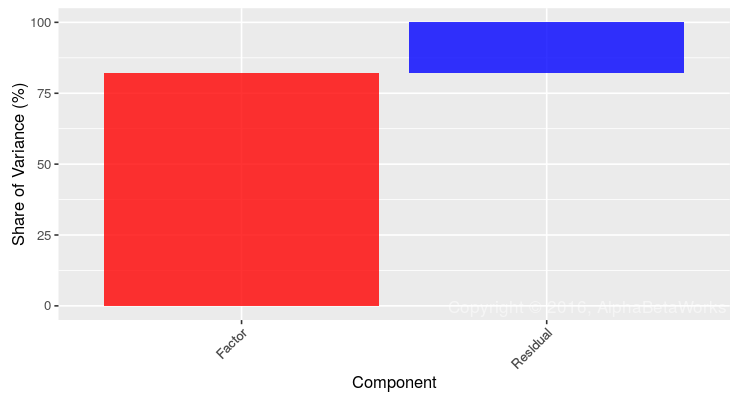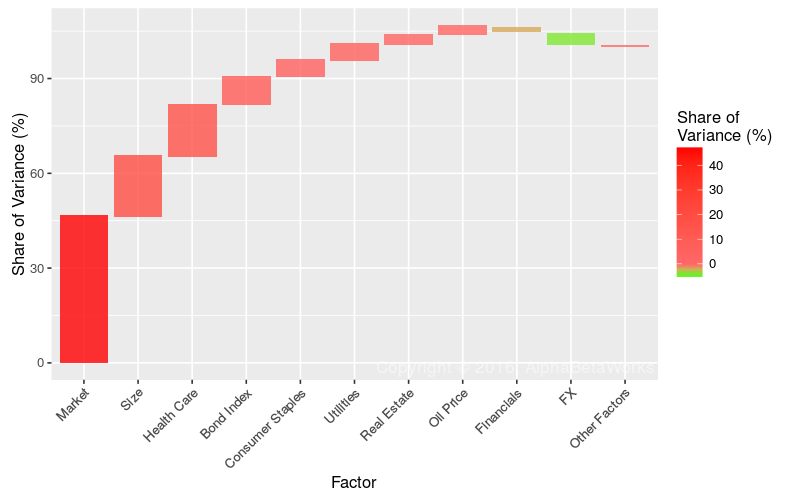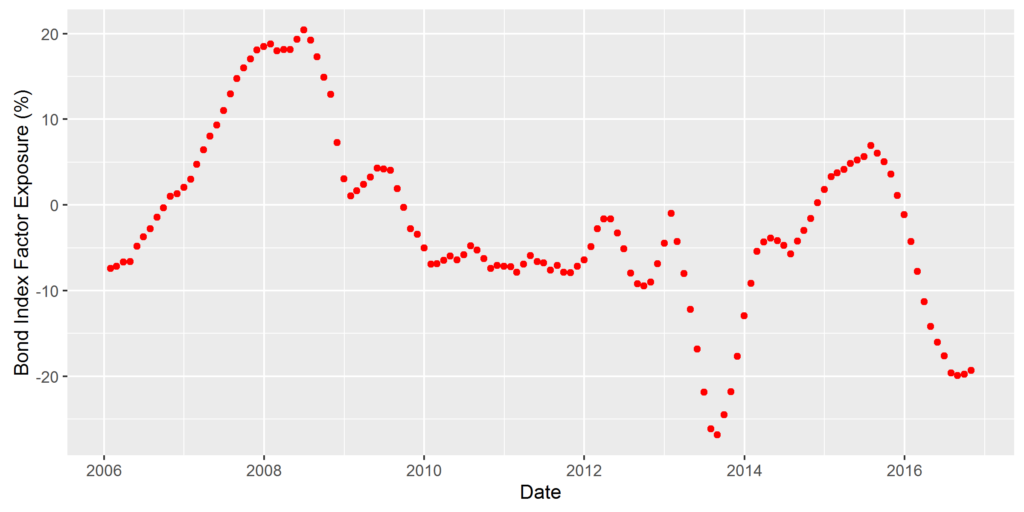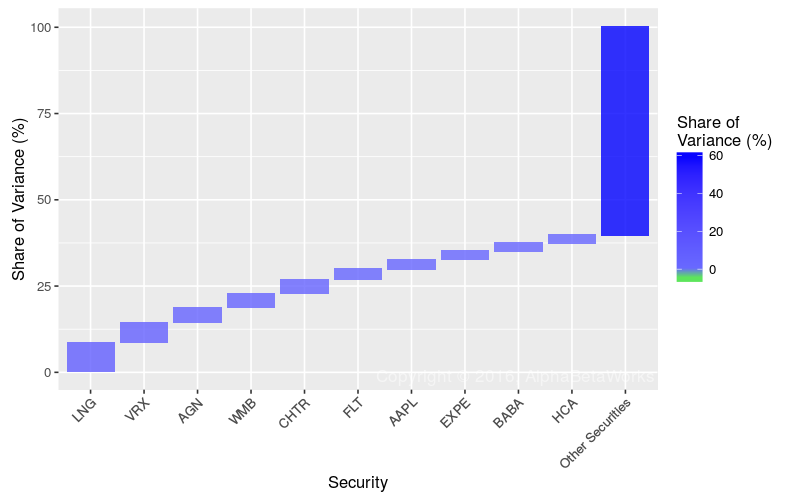Whereas most analysis of hedge fund crowding focuses on individual stocks, over 85% of hedge funds’ recent long equity variance has been due to their factor (systematic) risk. Residual, idiosyncratic, or stock-specific bets accounted for less than 15%. Thus, factor crowding has dominated hedge fund industry’s absolute and relative returns. This article reviews the most crowded hedge fund long equity bets at 9/30/2016.
Understanding and quantifying this factor crowding is vital for hedge fund investors and allocators: Factor exposures that are shared by the entire hedge fund industry and that can be obtained cheaply with passive funds do not warrant the same compensation as the distinctive insights of gifted managers. Even worse, crowded bets expose investors to damaging stampedes during liquidations.
Identifying Hedge Fund Crowding
This article’s approach follows our earlier studies of hedge fund crowding: We started with a 10-year survivorship-free dataset of SEC filings by over 1,000 hedge funds. We then created a position-weighted portfolio (HF Aggregate) comprising all hedge fund long U.S. equity portfolios that can examined using the filings. We analyzed HF Aggregate’s risk and its historical exposures relative to the U.S. Market. The top contributors to hedge fund industry’s relative risk are the industry’s most crowded bets. Factor exposures were analyzed using the AlphaBetaWorks (ABW) Statistical Equity Risk Model – an effective predictor of future risk.
Hedge Fund Industry’s Risk
The 9/30/2016 HF Aggregate had 3.9% estimated future volatility (tracking error) relative to the U.S. Market. Less than 20% of this risk came from individual stocks, or from stock-specific crowding; the remainder – more than 80% – came from factor (systematic) crowding:
| Source | Volatility (ann. %) | Share of Variance (%) |
| Factor | 3.50 | 82.19 |
| Residual | 1.63 | 17.81 |
| Total | 3.86 | 100.00 |
Since residual risk accounts for just 18% of the total, basic analysis of hedge fund crowding that examines popular holdings and position overlap is misguided. Such stock-specific analysis of crowding covers less than 20% of the industry’s risk, overlooking the dominant 80% of hedge fund crowding that is due to factors – a fatal flaw. Even funds with no shared positions correlate highly when they have similar factor exposures, so simplistic analysis of popular holdings and of position overlap understates portfolio risk and fosters complacency.
Hedge Fund Factor (Systematic) Crowding
Below are HF Aggregate’s principal factor exposures (in red). The U.S. Market, defined as the iShares Russell 3000 ETF (IWV) is the Benchmark (in gray). These factors are the primary sources of risk in the table above:
The dominant bet of hedge funds’ long equity portfolios is Market (high Beta):
| Factor | Relative Exposure | Factor Volatility | Share of Relative Factor Variance | Share of Relative Total Variance |
| Market | 20.65 | 10.59 | 46.19 | 37.97 |
| Size | -14.67 | 8.62 | 19.06 | 15.66 |
| Health Care | 12.68 | 7.54 | 16.22 | 13.33 |
| Bond Index | -19.34 | 3.37 | 8.94 | 7.35 |
| Consumer Staples | -7.87 | 7.24 | 5.28 | 4.34 |
| Utilities | -3.40 | 12.46 | 5.00 | 4.11 |
| FX | 10.70 | 6.80 | -4.22 | -3.47 |
| Real Estate | -1.86 | 12.80 | 2.97 | 2.44 |
| Oil Price | 1.03 | 30.15 | 2.75 | 2.26 |
| Financials | -4.84 | 7.05 | -2.09 | -1.72 |
(Relative exposures and relative variance contribution. All values are in %. Volatility is annualized.)
This high U.S. Market exposure alone is twice as influential as all the stock-specific bets combined. Given this importance of factor crowding compared to residual crowding, popular fascination with fund holdings and position overlap is especially dangerous. Asset managers’ and allocators’ endurance thus depends increasingly on their edge in assessing systematic crowding.
Hedge Fund Short Bonds/Long Interest Rates Factor Crowding
HF Aggregate’s exposures to Market, Size, and Health Factors were near their peak levels seen in recent quarters. In addition to these, their Short Bonds/Long Interest Rates Factor exposure has also recently reached historic extremes:
We discussed the fundamental sources of this Bonds/Interest Rates Factor exposure in a prior article. Short bond risk is a natural consequence of hedge funds’ fondness for financially leveraged companies, often viewed as “cheap call options.” A company’s indebtedness creates economic and statistically observable short bond exposure. Given the Q4 2016 moves in yields, this bet should prove profitable for the hedge fund industry.
Hedge Fund Residual (Idiosyncratic) Crowding
A fifth of hedge fund crowding on 9/30/2016 was due to residual (idiosyncratic, stock-specific) risk. The following stocks were the main contributors to residual hedge fund crowding:
| Symbol | Name | Relative Exposure | Residual Volatility | Share of Relative Residual Variance | Share of Relative Total Variance |
| LNG | Cheniere Energy, Inc. | 1.63 | 28.94 | 8.43 | 1.50 |
| VRX | Valeant Pharmaceuticals International Inc | 0.89 | 43.63 | 5.76 | 1.02 |
| AGN | Allergan plc | 1.86 | 18.17 | 4.32 | 0.77 |
| WMB | Williams Companies, Inc. | 1.28 | 25.87 | 4.12 | 0.73 |
| CHTR | Charter Communications, Inc. Class A | 1.69 | 19.27 | 4.01 | 0.71 |
| FLT | FleetCor Technologies, Inc. | 1.62 | 17.40 | 3.02 | 0.54 |
| AAPL | Apple Inc. | -1.90 | 14.29 | 2.78 | 0.50 |
| EXPE | Expedia, Inc. | 1.04 | 24.57 | 2.47 | 0.44 |
| BABA | Alibaba Group Holding Ltd. Sponsored ADR | 1.07 | 23.61 | 2.43 | 0.43 |
| HCA | HCA Holdings, Inc. | 1.10 | 21.96 | 2.22 | 0.40 |
(Relative exposures and relative variance contribution. All values are in %. Volatility is annualized.)
The importance of residual crowding diminished in recent quarters as factor crowding increased. Consequently, hedge fund stock-picking has faded in importance relative to market timing. The most crowded stocks are sensitive to asset flows in and out of the industry, but they are not the main threat to crowded portfolios. In the current environment of extreme systematic hedge fund crowding, investors and allocators should focus on the factor exposures. Without an accurate view of factor crowding, investors in a supposedly diversified hedge fund portfolio often end up paying high active fees for a passive factor portfolio.
Summary
- At Q3 2016, over 80% of hedge fund industry’s relative long equity risk was due to factor, or systematic, crowding.
- The main sources of Q3 2016 hedge fund crowding were high U.S. Market, short Size, long Health, and short Bonds/long Interest Rates Factor exposures.
- Short Bonds/Long Interest Rates Factor exposure reached historic extremes.
- Systematic exposures and risks shared across stocks, rather than individual positions, are driving 80% of the hedge fund industry’s long equity risk.
- Only robust analysis of factor and residual crowding can determine whether a hedge fund investor, follower, or allocator is investing in exceptional insights or in a generic passive factor portfolio.











